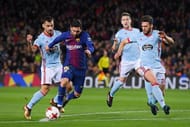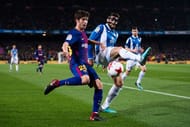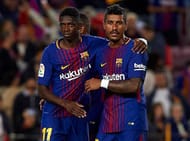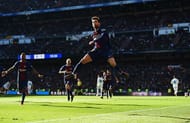
Ernesto Valverde arrived at FC Barcelona in the summer as the coach with the burden of lifting Barcelona from the dust after a below expectations season. In his previous coaching jobs, he has lifted the Greek Superleague on three occasions with Olympiacos. In Spain, he won the Spanish Super Cup with Athletic Bilbao in 2015. He did manage to help Athletic qualify for the Europa League on four consecutive occasions. Doing some wonders on his previous coaching jobs, some people had high expectations from him but most of the fans underestimated him but now he has proved himself to be one of the best coaches of La Liga. While no one thought that if Barcelona would be challenging for the title, Valverde's masterclass turned the whole equation upside-down. Let's take a detailed look at the tactics used by Valverde.
Is Valverde redefining Tiki-Taka?

Tiki-taka was the key tactic used by Pep Guardiola during his excellent season at Barcelona when he led European Giants to win treble but Valverde’s ideas are much more reserved and balanced. He is very conscious of being balanced attack-wise and defense-wise, solid and not offering any weaknesses to opponents. Valverde is active before games as well as during the games.
The example of his pre-game tactics was against Real Madrid when he instructed the team to sit back in the first half and attack in the second half while his in-game tactics helped FC Barcelona to make a comeback against Real Sociedad. In their 0-5 victory over Real Betis, during the first half Barcelona was struggling to press but in the second half, they showed an excellent tiki-taka style passing which led them to victory.
How did Valverde fill the vacant position of Neymar?

When Neymar left the club, he left a hole in the Barcelona squad because there was no other quality winger with the club but later they got Dembele as a replacement but it was a short-lived joy for FC Barcelona fans as he got injured. Valverde had a tough task ahead of him but he handled it so well that Barcelona is still unbeatable in La Liga.
At the start of the season, Valverde instructed the players to press high on the pitch. For example, against Real Betis, Barcelona was pressing forward, but they do not use the same tactic for every game. Valverde is using 4-4-2 formation during most of the matches where Messi drops back to play in midfield and Suarez stays up front. When Neymar left the team, left flank was wide open for the oppositions to explore but during the initial phase of the season, Valverde used Gerard Deulofeu on the left flank with the support from Jordi Alba. Whenever he used Deulofeu, he was going with 4-3-3. But Deulofeu did not have any attributes which could help the club in the long term so Valverde started using 4-4-2.
Redefining the Defense

After getting smashed by 5-1 of the hands of their arch-rivals in UEFA Super Cup, it was clear that Barcelona's defense was leaking the goals more than their standards. Jordi Alba and Sergi Roberto offer plenty of width as attacking full-backs while in possession, giving license to Andres Iniesta, Ivan Rakitic, and Lionel Messi to drop-in wherever necessary. The combinational play between the players that occupy the wider areas and their support to fullbacks is vital to allow Barcelona to overload at the flanks against stretched opposition defenses.
Sergio Busquets drops deep to collect the ball from Ter Stegen and Barca’s centre-backs split to allow their full-backs to push on and take up an advanced starting position if possible. Defensively, Valverde likes for his bank of four defenders to retreat into position, with the midfield then plugging the gaps ahead in their own bank of four. If certain midfielders are caught a little out of position when possession turned over, they can fill in as they see fit.
In terms of pressing defensively against teams that are comfortable in possession, Barcelona tries to press high and go forward. Luis Suarez shows that pressing isn’t always the key intention for Valverde’s forwards because sometimes he drops back. The most important change that Valverde made to defense is that when they lose possession, every player (except Suarez) drops back to defend as a unit.
Where to fit Iniesta and Paulinho?

At the age of 33, it is clear that Andres Iniesta’s footballing life expectancy won’t stretch much longer. Under Valverde, however, his aging legs are being used effectively. By using the athleticism of Alba down the left wing, Iniesta can tuck in and look to either attack the box more centrally or slide passes either in between the lines or behind the opposition right back, as well as having the time to switch play. It gives him the freedom to be creative, as well as negating the amount of hard running or defensive work that he would be asked to do as a flat central midfielder.
Paulinho was an interesting purchase for Barcelona during the summer of 2017. Having failed to set his mark in the Premier League with Tottenham, there was not much optimism with regard to what he could offer a big club that would be challenging for titles. Given his physicality and stature, however, the Brazilian had a clear skill set that did not previously exist within the club’s ranks. He is being used as a link from midfield to the front two of Messi and Suárez, with his power aiding his runs from deep or ability to challenge for aerial or loose balls in or around the box. He has the freedom to step up, while Ivan Rakitic and Sergio Busquets cover the required central midfield space off the ball. Paulinho can play neatly off the front two, or get in the box to help challenge for deliveries from wide areas, with his height and broad physique giving Valverde’s forward line a physical edge they previously lacked.

The key player in Valverde's tactics

Perhaps the key aspect of Valverde’s Barcelona is the freedom that is given to Lionel Messi. Left to his own devices as a floating presence alongside Luis Suarez, while the Suarez plays as a 9, Messi finds pockets of space that he wants to exploit. With Rakitic and Sergi Roberto offering the width on the right when Barcelona is in possession, it releases Messi to go hunting for where he can do damage - and it is precisely that liberty for the Argentine that makes Barcelona well structured, yet infinitely unpredictable, or even unstoppable, in the attack.
Valverde’s blend of balance and star quality makes them an interesting proposition for both domestic and European glory this season.
